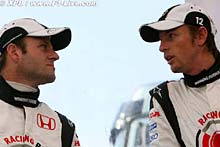(A really good resource is http://quattroporte.online.fr/ , which is run by a proud Quattroporte IV owner.)
Quattroporte I (1963-69): The Rat Packer
 If I were a betting man, I would wager that at least one or two Rat Packers had one of these puppies. A detuned racing engine was stuffed under the bonnet. The 4.1 liter V8 used all 256 horses to achieve an incredible 143 mile per hour top speed. Moreover, the styling equalled the awe-inspiring performance.
If I were a betting man, I would wager that at least one or two Rat Packers had one of these puppies. A detuned racing engine was stuffed under the bonnet. The 4.1 liter V8 used all 256 horses to achieve an incredible 143 mile per hour top speed. Moreover, the styling equalled the awe-inspiring performance.Quattroporte II (1974-78): The Flop
 Only 13 of these were ever made. It shared many components with the Citroen SM, including the chassis, the hydropneumatic suspension, FWD set-up, and swivelling headlights. An asthmatic Merak V6 producing less than 200 horsepower was used. To put it simply: It just ain't right.
Only 13 of these were ever made. It shared many components with the Citroen SM, including the chassis, the hydropneumatic suspension, FWD set-up, and swivelling headlights. An asthmatic Merak V6 producing less than 200 horsepower was used. To put it simply: It just ain't right.Quattroporte III (1976-90): The Icon
 For most, this is the Quattroporte that comes to mind. It was meant to compete with the Benz 450SEL 6.9 (of recent Ronin fame). The controversial styling was a favorite among Italian magnates. If anything, it definitely stood out in the crowd.
For most, this is the Quattroporte that comes to mind. It was meant to compete with the Benz 450SEL 6.9 (of recent Ronin fame). The controversial styling was a favorite among Italian magnates. If anything, it definitely stood out in the crowd.Quattroporte IV (1994-2000): The Unremarkable
 Though I am a pretty big car nut, this version of the fourdoor flew completely under the radar. I did not learn of it until very recently. Though it performed well on the road (it has a 158 mph top speed when coupled with the 330 hp V8), it looks like an anonymous Japanese sedan. Too much emphasis was placed on aerodynamics. No effort was made to connect it with its northern Italian roots.
Though I am a pretty big car nut, this version of the fourdoor flew completely under the radar. I did not learn of it until very recently. Though it performed well on the road (it has a 158 mph top speed when coupled with the 330 hp V8), it looks like an anonymous Japanese sedan. Too much emphasis was placed on aerodynamics. No effort was made to connect it with its northern Italian roots.Quattroporte V (2004-present): Turtle Chic
 Aside from the jerky transmission, this sedan is perfect. When I saw Vincent Chase's Entourage ride in one, it was perfect. With a 400 horsepower Ferrari engine capable of reaching 60 in 5 seconds flat, this car not only looks fast. It is fast.
Aside from the jerky transmission, this sedan is perfect. When I saw Vincent Chase's Entourage ride in one, it was perfect. With a 400 horsepower Ferrari engine capable of reaching 60 in 5 seconds flat, this car not only looks fast. It is fast.CKY









































